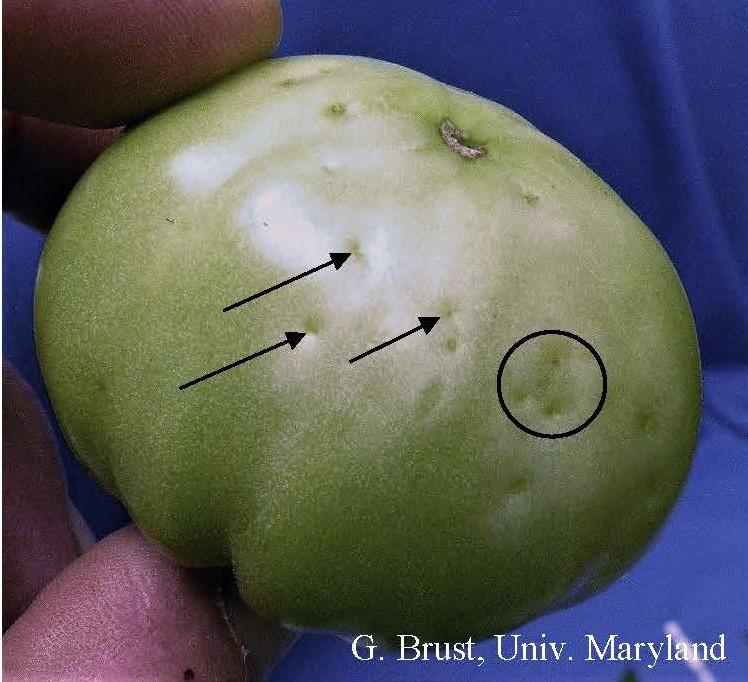Spotted Wilt Virus in Tomatoes
A couple of high tunnels and even a field of tomatoes have been found with tomato spotted wilt virus in Maryland. The high tunnel finds were not too suprising but the field was a bit as we usually do not see field infections until later in the season.
Tomato spotted wilt virus (TSWV) is an obligate parasite, i.e., it must have a living host and must be moved from one plant to another by thrips or through cuttings or possibly seed. This disease can affect tomato and other Solanaceae crops as well as lettuce, beans, cucumber and 170 other plant species. TSWV may occur in the field but tends to affect greenhouse and high tunnel crops more severely. TSWV is transmitted most efficiently by Western flower thrips (WFT) (Frankliniella occidentalis), and less so by Onion thrips (Thrips tabaci), Tobacco thrips (Frankliniella fusca) and several other thrips species. It is not transmitted by Eastern flower thrips (Frankliniella tritici).


Western flower thrips completes its life cycle in about 10-18 days. Eggs are laid in the leaf or tomato fruit. When WFT oviposit into tomato fruit they often cause a deeper dimple (fig. 1) than other thrips species and very often the dimple is surrounded by a white halo of tomato tissue. Larvae hatch in about three days and immediately begin to feed and in so doing pick up the virus. After four days, they pupate in the soil, and in a little over three days, the pupae become adults. Only immature thrips can acquire the virus, which they can acquire within 15 minutes of feeding, but adults are just about the only stage able to transmit the virus. Adults can transmit the virus for weeks. It may take 2 - 4 weeks from when the adult thrips first fed on a plant to initial symptom occurrence. Because of this TSWV appears to worsen in plantings over time.
TSWV infected leaves may show small, dark-brown spots or streaks (fig. 2) on stems and leaf petioles (we found one weed sample with such a symptom). Growing tips are usually affected with systemic necrosis and potentially stunted growth. Tomato fruit will have mottled, light green or yellow spots or rings usually with raised centers (fig 3).
Weed hosts act as important virus reservoirs for TSWV and can survive in and around greenhouses, high tunnels or fields. Some of these weeds include prickly lettuce, chickweed, spiny amaranth, lambsquarters, black nightshade, shepherd’s purse, galinsoga and burdock.
We tested for both INSV and TSWV on the tomatoes, weeds and on any bedding plants that were in the same greenhouse as the tomatoes. Only TSWV was found in the tomato and some of the weeds. No INSV was found in any sample. Although both viruses are transmitted by the same thrips species these viruses tend to infect either bedding plants (INSV) or tomato/pepper plants (TSWV). The 2020-2021 Mid-Atlantic Commercial Vegetable Production Recommendations guide has recommendations for both greenhouse and field management of the thrips that vector TSWV. Never grow vegetable transplants in the same greenhouse with bedding plants.
